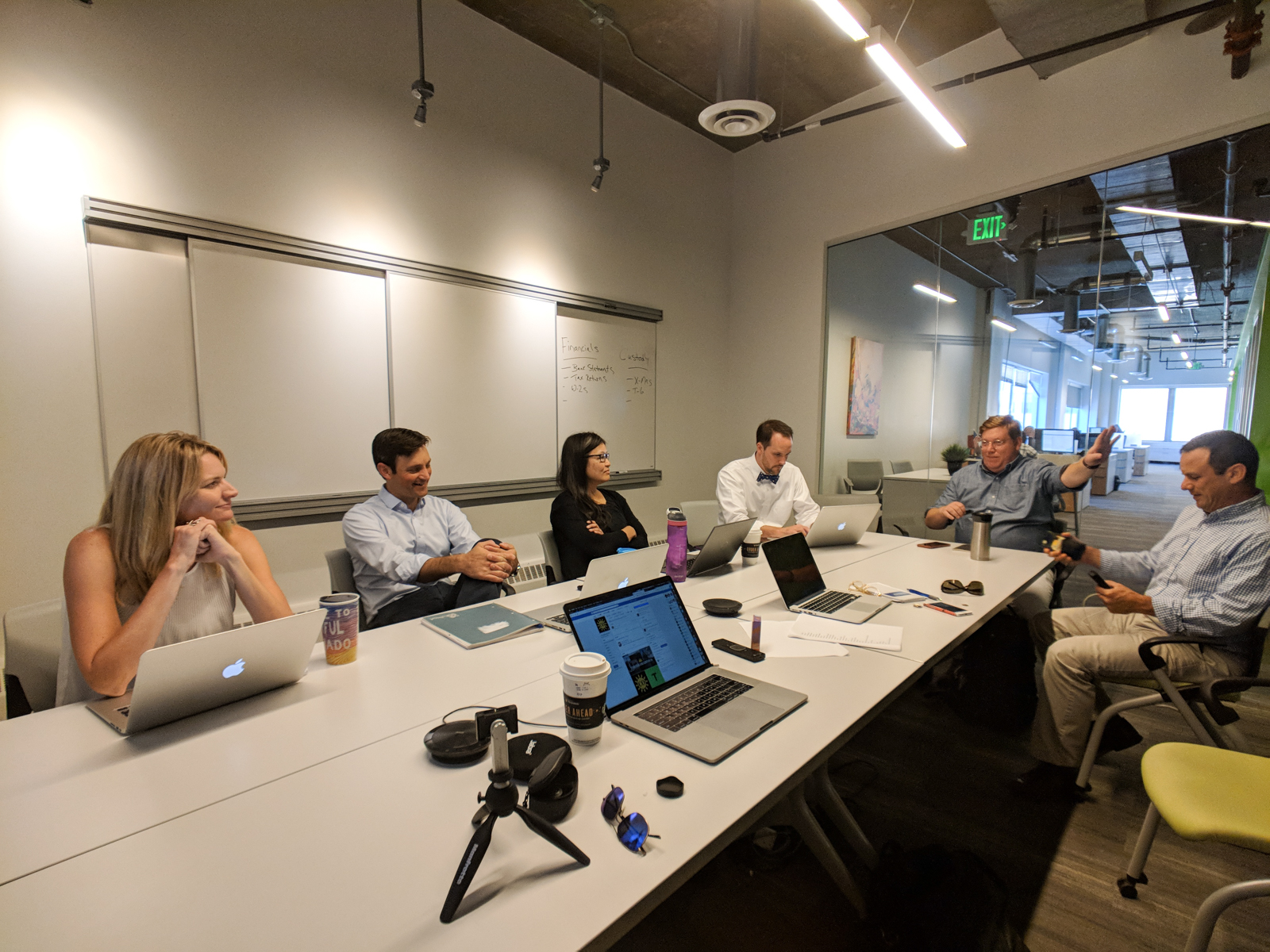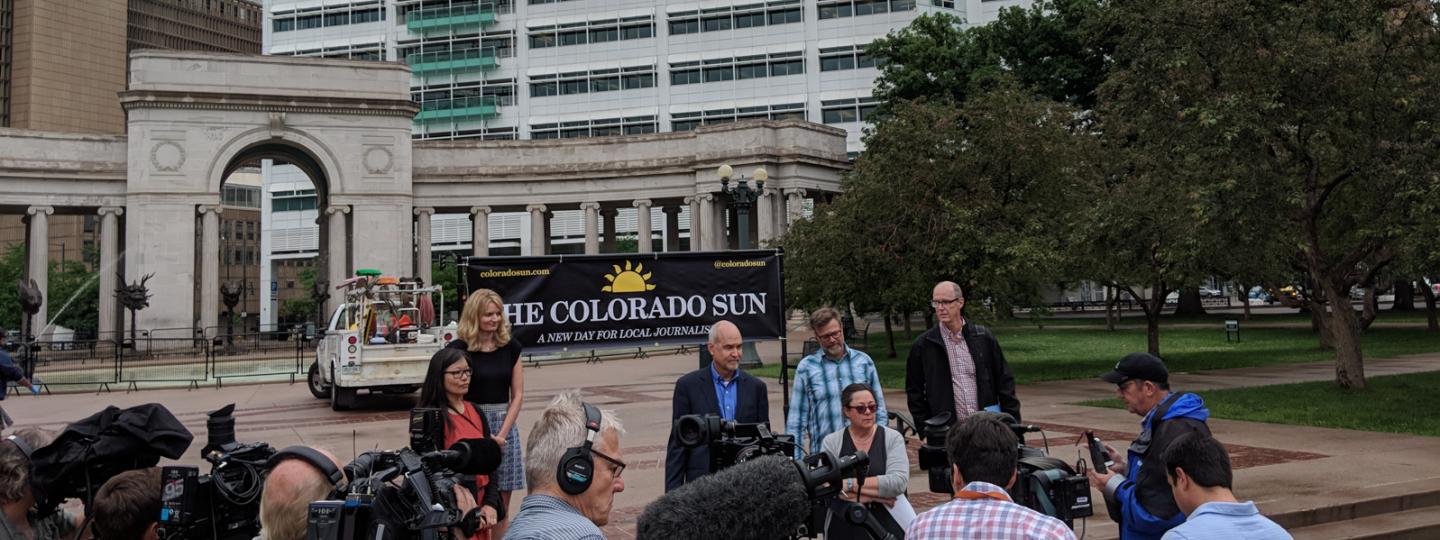Colorado is “a big lab for media,” Dana Coffield believes.
New publications across the state have experimented with funding and content to fill coverage gaps left by shrinking legacy newspapers. A staff of departed Denver Post employees, including Coffield, are getting ready to launch the next new outlet: The Colorado Sun.
Coffield and editor Larry Ryckman, both former Post editors, announced their plans in June for a digital newsroom focusing on in-depth journalism across the entire state.
They’re working with eight other Post veterans to launch the Sun in early September. The goal: quality investigative, explanatory and narrative reporting on issues facing the whole state, not just Denver.
“That sort of journalism helps bring understanding to readers,” Ryckman said. “It’s not about breaking news for us, but we intend to break news.”
The journalists launching the Sun resigned from the Post this spring after layoffs from its hedge fund owners had pared down its staff over and over. Shrinking newsrooms aren’t new for the state’s capital — Denver had two daily newspapers until 2009, when the Rocky Mountain News closed.
The journalists know a startup and a new business model are risky, Ryckman said, but they believe the risks are worth it. The journalists want to use their experience and institutional knowledge to bring deeper coverage and more collaboration to the Colorado news landscape.
“We aim to be an intelligent voice, a thoughtful voice that brings stories of people to light,” reporter John Ingold said. “A lot of times news outlets are able to do this sporadically, but we hope to do that consistently and in ways that makes the community feel more united and creates understanding.”

How it came together
When Alden Global Capital, the owner of Digital First Media, ordered the Post to cut one-third of its newsroom in March, “that sent a shock wave through our newsroom and the country,” Ryckman said.
The remaining staff had already taken on more and more work, and Coffield said she realized she couldn’t do it anymore. She started looking for other options.
In April, the Post called out its owners: “If Alden isn’t willing to do good journalism here, it should sell The Post to owners who will,” the editorial board wrote.
Soon after, Ryckman wrote a story about editorial editor Chuck Plunkett’s resignation. When he was told he couldn’t use the words “Alden Global Capital” in the story, that was the final straw, Ryckman said. He submitted his own resignation.
Civil, a media startup funding journalism through cryptocurrency and blockchain technology, had already approached him about creating a new outlet in Colorado. After Ryckman resigned, conversations turned into concrete plans.
“It was clear to me it’s time to try something new,” Ryckman said. “The old models just don’t work. We know all too well what corporate, hedge fund-owned journalism looks like. It’s not a pretty picture.”
Civil is funding two years of the Sun’s operations, and the staff is finalizing its business plan for memberships and subscriptions. Readers won’t have to learn about blockchain and cryptocurrency if they don’t want to, technology and strategy head Eric Lubbers said — the Sun will accept subscriptions in U.S. dollars.
“Lots of people’s only exposure to cryptocurrency is hearing news stories about bitcoin and imagining people in basements mining things,” Lubbers said. “The big thing about Civil is they’re trying to use blockchain more for governance and ethics, community control, than using it as a currency.”
A Kickstarter campaign raised $161,493 from more than 2,600 individual donors in June and July. The staff plans to use those funds for freelance visual work, public records requests and freelance writers across the state.
Colorado readers have been excited and supportive, reporter Jennifer Brown said.
“There’s a healthy appetite out there for something new and better, something that will give them stories they’ll relate to and think about after they’ve finished reading,” she said. “We’ve gotten a lot of people ready to sign up even though we haven’t launched yet.”

Building a newsroom
The work since the June announcement then has been the same as building a startup from scratch, Lubbers said — something journalists don’t have to think about when they’re coming into an established news outlet. The team’s newsroom is a shared coworking space in downtown Denver.
Lubbers has worked with Civil to build the bones of the website. The whole staff has worked together to develop a business plan and build relationships with freelancers, especially visual journalists.
Having to focus on business development is challenging, Brown said — she wants to be able to develop story ideas and report. She spent 13 years at the Post, where her reporting focused on social services and social justice issues.
“It’s exciting to get to build something from scratch,” she said. “It’s like being my own boss for the first time in my life. We’re only going to do stories we think are legitimate, important, meaningful stories for Colorado.”
The reporters don’t have formalized beats, but they all have areas of expertise and interest from their time at the Post. John Frank focuses on politics, Jason Blevins covers the outdoors and Tamara Chuang focuses on technology.
“It’s an open opportunity to be the journalist you’ve always wanted to be and always told yourself you could be,” said Ingold, who spent 17 years at the Post. “There’s some anxiety that comes with that too; it’s a big test in a way. You need to show people you can be who you say you are.”
To establish the Sun’s presence throughout the state, the editors are exploring partnerships with local outlets and asking readers about their concerns in weekly newsletters. More than a quarter of reader responses to newsletters have come from outside the Denver area and surrounding cities, Coffield said.
The journalists said they don’t see themselves as competitors to the Denver Post, and emphasized that they still appreciate the work the Post is doing.
There are plenty of stories going unreported across the state, Ingold said. He’s said he’s looking forward to being part of a more collaborative news environment to serve the people of Colorado.
“We’re all working toward having an amazingly robust newsgathering environment so that the government doesn’t get away with anything,” Coffield said. “The more of that, the better.”

Covering a diverse state
Part of covering the whole state means reflecting all points of view in news coverage, Coffield said, but some readers have questioned the Sun’s lack of ethnic diversity.
“A cadre of white men? I want @coloradosun to succeed, but you're not building a diverse team,” Eric Budd tweeted after the Sun announced the hiring of reporter Jesse Paul.
Nine of the Sun’s ten staffers are white, and seven of those are men. 31 percent of Colorado’s population is nonwhite, as is 46 percent of Denver’s, according to Census Bureau data.
Coffield said the staff is “hyper aware” of the issue and is working to increase its diversity through freelancers until hiring more full-time journalists. They’ve talked with minority journalists about joining the team, Ryckman said.
“Diversity takes in a lot of things,” Coffield said. “In order for us to cover the state effectively, we have to have a diverse workforce, diversity of experience, age, gender, economic status.”
Other Denver media startups like the InDenver Times, the Rocky Mountain Independent and Colorado Public News failed due to lack of interest or subscribers after the Rocky Mountain News folded. Coffield said she thinks the Sun will be different because of the timing. The journalists understand better how audiences consume news digitally, and readers aren’t surprised to hear that the Sun will be online only.
Ultimately, Ryckman said, the Sun’s success is up to readers.
“Either we provide the kind of journalism people want and are willing to support, or we don’t,” he said. “I’m optimistic that we’re going to do that good work.”






